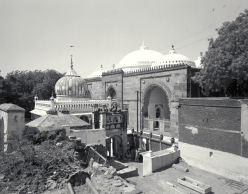M02
ジャマート=ハーナ(Jam![]() `at
`at ![]()
![]() nah)として知られており,ニザームッディーン=オーリヤーの墓のすぐ西側にある。附図.I-9
nah)として知られており,ニザームッディーン=オーリヤーの墓のすぐ西側にある。附図.I-9
この建物は,赤い砂岩を豊富に用いた美しいモスクで,東側にそれぞれ入口を開く三つの部屋からなっている。中央の部屋は,比較的平坦なドームをいただく四角の平面をもっており,西側には,中央ミヒラーブとそれをはさんで二つの龕が設けられている。東側には,入口の左右に窓があけられ,南側と北側には,側室に通じるそれぞれ二つの通路が開かれている。中央ミヒラーブの周辺や四隅のスクィンチアーチには,東側の入口外部と同じように,碑文と文様がほどこされ,第I期の特徴をよく示している。南北の側室は,長方形の平面をもっており,いずれもアーチによって二つの部分に仕切られ,それぞれ二つのドームをのせている。これらの側室は,中央の部屋と異なって,装飾にとぼしく,現在では,白い塗装が全面にほどこされている。
このモスクの建設の歴史については,さまざまの伝承が伝えられ,また,異なった見解が述べられているが,おそらくは,ニザームッディーン=オーリヤーの宗教活動に関連して,デリー諸王朝時代の初期の後半に建てられたものと思われる。このモスクは,今日もなお,礼拝の場として使用されており,内部には,随所に改変や彩色がほどこされている。とくに,ニザームッディーン=オーリヤーのダルガーは,インド有数のイスラーム教徒の聖地としてひろく知られているので,イスラームの祭日には,ダルガーをおとずれる信徒でにぎわっている。第Ⅰ期。
東研.Ⅲ-7;ASI.Ⅱ-200
Jam![]() `at Kh
`at Kh![]() na Masjid. Situated on the western side of the shrine (darg
na Masjid. Situated on the western side of the shrine (darg![]() h) of Ni
h) of Ni![]()
![]() m al-D
m al-D![]() n Awliy
n Awliy![]() ’.
’.
Grid ref. I-9; Ill. 11-12a.
This beautiful building, constructed with the prolific use of red sandstone, consists of three cojoined rooms with a facade of three arches, one for each of the rooms, opening out on the eastern side. The central chamber has a comparatively flat dome and a square plan, with a mi![]() r
r![]() b on the western wall and two blind arches on either side of it. Two latticed windows flank the central archway on the eastern side, and corridors on the northern and southern sides of the main chamber connect it to the adjoining rooms. The area around the mi
b on the western wall and two blind arches on either side of it. Two latticed windows flank the central archway on the eastern side, and corridors on the northern and southern sides of the main chamber connect it to the adjoining rooms. The area around the mi![]() r
r![]() b and the corner squinches are richly decorated with patterns and inscriptions, as is the outer section of the eastern doorway. This is characteristic of Period I. The adjoining rooms are rectangular in plan and are each further divided by an archway. Each portion is topped with a small dome. Unlike the central chamber, these rooms are undecorated and today are completely covered in whitewash.
b and the corner squinches are richly decorated with patterns and inscriptions, as is the outer section of the eastern doorway. This is characteristic of Period I. The adjoining rooms are rectangular in plan and are each further divided by an archway. Each portion is topped with a small dome. Unlike the central chamber, these rooms are undecorated and today are completely covered in whitewash.
Various traditions exist relating to the history of this mosque, and many different opinions are held. It is thought to have been built in the latter half of the early Delhi Sultanate, in connection with the religious activities of the Sufi saint Ni![]()
![]() m al-D
m al-D![]() n Awliy
n Awliy![]() ’ (1236-1325). It is still used as a place of worship. The interior has been completely renovated and painted. The shrine (darg
’ (1236-1325). It is still used as a place of worship. The interior has been completely renovated and painted. The shrine (darg![]() h) of Ni
h) of Ni![]()
![]() m al-D
m al-D![]() n Awliy
n Awliy![]() ’ is a popular place of pilgrimage, and is one of the most famous shrines in India. Period I.
’ is a popular place of pilgrimage, and is one of the most famous shrines in India. Period I.
IOC:Ⅲ-7; ASI:Ⅱ-200.





